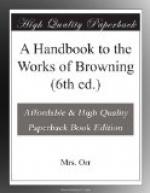“Pauline” did not take its place among the author’s collected works till 1868, when the uniform edition of them appeared; and he then introduced it by a preface (to which I have just alluded) in which he declared his unwillingness to publish such a boyish production, and gave the reasons which induced him to do so. The poem is boyish, or at all events youthful, in point of conception; and we need not wonder that this intellectual crudeness should have outweighed its finished poetic beauties in its author’s mind. It contains however one piece of mental portraiture which, with slight modifications, might have stood for Mr. Browning when he re-edited the work, as it clearly did when he wrote it. It begins thus (vol. i. page 14):
“I am made up of an intensest life,”
The tribute at page 14[9] to the saving power of imagination is also characteristic of his maturer mind, though expressed in an ambiguous manner. It is interesting to know that in the line (page 26),
“the
king
Treading
the purple calmly to his death,”
he was thinking of Agamemnon: as this shows how early his love of classic literature began. The allusion to Plato, at pages 19, 20, and 21, largely confirms this impression. The feeling for music asserts itself also at page 18, though in a less spiritual form than it assumes in his later works. But the most striking piece of true biography which “Pauline” contains, is its evidence of the young writer’s affectionate reverence for Shelley, whom he idealizes under the name of Sun-treader. An invocation to his memory occupies three pages, beginning with the ninth; it is renewed at the end of the poem, and there can be no doubt that the pathetic language in which it is couched came straight from the young poet’s own heart. We even fancy that Shelley’s influence is visible in the poem itself, which contains a profusion of natural imagery, and some touches of naturalistic emotion, not at all in keeping with Mr. Browning’s picturesque, but habitually human genius. The influence, if it existed, passed away with his earliest youth; not so the admiration and sympathy which it implied; and this, considering the wide difference which separated the two minds, is an interesting fact.[10]
“PARACELSUS.” (1835.)
“Paracelsus” is a summary of the life, as Mr. Browning conceives it, of this well-known physicist of the sixteenth century; and is divided into five scenes, or groups of scenes, each representing a critical moment in his experience, and reviewing in his own words the circumstances by which it has been prepared. The personages whom it includes are, besides the principal one, Festus and Michal, early friends of Paracelsus, and now man and wife; and the Italian poet Aprile. Michal appears only in the first scene; Aprile in the second or third; but Festus accompanies Paracelsus




